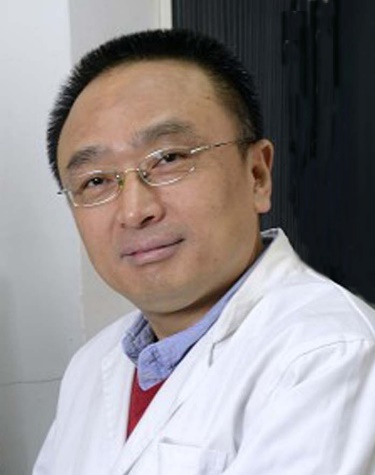柯尊记 研究员

柯尊记,博士,博士研究生导师,上海中医药大学中西医结合研究院副院长。先后在中国科学院上海脑研究所,美国University of Illinois at Chicago 和Cornell University Weill Medical College从事博士后研究。2003年12月任中国科学院营养科学研究所研究员,神经营养科学研究组组长。2014年5月加入上海中医药大学基础医学院,任神经科学研究中心主任。
主要研究兴趣:1)中西医结合防治神经退行性疾病。2)老年性神经元死亡的生物学机制。3)酒精等环境因素对神经系统发育和衰老影响机制。
柯博士的研究发现了氧化代谢紊乱、氧自由基产生增加、免疫/炎症反应是氧化代谢紊乱引起的神经元死亡的重要病理生理过程;内质网应激、未折叠和错误折叠蛋白累积是参与氧化代谢紊乱引起的神经元死亡的主要细胞机制。氧化代谢紊乱通过调节RNA编辑参与代谢型谷氨酸受体mRNA剪切过程,从而改变神经元代谢型谷氨酸受体的钙通透能力、引起细胞钙调节功能紊乱,导致神经元死亡。证实神经元产生的单核细胞趋化因子,是氧化代谢紊乱诱发免疫/炎症反应的开关分子。发现氧化代谢紊乱可以通过增强β分泌酶的活性增加β淀粉样蛋白的产生,从而加速神经元病变的发展过程。维生素B1缺乏可增加淀粉样蛋白的产生,亚临床维生素B1缺乏是老年性痴呆的危险因素之一。复方中药可明显改善AD模型动物的学习记忆能力,减少老年斑的形成,抑制炎症反应。已在Neurobiol Aging, J Immunol, J Neurochem, J. Neuropath. Exp. Neurol和J. Biol. Chem等国际学术期刊发表论文80余篇,获得专利授权2项。
任中国老年医学学会基础与转化医学分会委员,中国细胞生物学学会神经细胞生物学分会委员,上海市神经科学学会理事,上海市中西医结合学会理事。主编十三五规划教材”《医用化学与生物化学》,任Biochemistry and Cell Biology编委。入选中国科学院“百人计划”,上海市“浦江人才计划”。
Dr. KE Zunji, Vice Dean
KE Zunji, Ph.D., Doctoral student supervisor;
Vice Dean of Academy of Integrative Chinese and Western Medicine, Shanghai University of Traditional Chinese Medicine;
Director of the Neuroscience Research Center, Shanghai University of Traditional Chinese Medicine;
Former postdoctoral researcher at the Shanghai Brain Research Institute of the Chinese Academy of Sciences, the University of Illinois at Chicago and the Cornell University Weill Medical College.
Researcher at the Institute of Nutrition and Health of the Chinese Academy of Sciences and the leader of the NeuroTrition Research Group since 2003 to 2014.
Main research interests: 1) Integrative Chinese and Western medicine to prevent and treat neurodegenerative diseases; 2) Biological mechanisms ofneuronal cell death in the aging brain; 3) Mechanisms of external factors such as alcohol affecting the development and aging of the nervous system .
Dr. KE found that disorders of oxidative metabolism, increased production of oxygen free radicals, and immune-inflammatory responses are important pathophysiological processes of neuronal death caused by oxidative metabolic disorders, in which endoplasmic reticulum stress, unfolded, and misfolded protein accumulation are involved in the main cellular mechanism of neuronal death caused by oxidative metabolic disorders. Disorders of oxidative metabolism are involved in the metabotropic glutamate receptor mRNA cleavage through regulating RNA editing, thereby altering the calcium permeability of neuronal metabotropic glutamate receptors, causing intracellular calcium dysregulation and leading to neuronal cell death. It is confirmed that the monocyte chemotactic factors expressed by neurons are the molecular switch that induces an immune-inflammatory response caused by oxidative metabolism disorders. It was found that disorders of oxidative metabolism can increase the production of β-amyloid by enhancing the activity of β-secretase, thereby accelerating neurodegeneration. Vitamin B1 deficiency increases amyloid production, and subclinical vitamin B1 deficiency is one of the risk factors for Alzheimer's disease. Compound Chinese medicine can significantly improve the learning and memory skills of animal models of Alzheimer’s disease, reduce the formation of senile plaques, and inhibit the inflammatory response. Dr. KE has two patents and published more than 80 articles in Neurobiol Aging, J Immunol, J Neurochem, J. Neuropath. Exp. Neurol and J. Biol. Chem ,etc.
He is a member of Basic and Translational Medicine Branch of Chinese Geriatrics Society, a member of the neural cytology committee of Chinese Society for Cell Biology, a council member of Shanghai Society for Neuroscience, and a council member of Shanghai Association of Chinese Integrative Medicine. Dr. KE is an editor-in-chief of the 13th Five-Year Plan textbook Medical Chemistry and Biochemistry, and is a member of the editorial committee for Biochemistry and Cell Biology. Besides, he was recruited into the Hundred Talents Program of Chinese Academy of Sciences and the Shanghai Pujiang Talent Program.